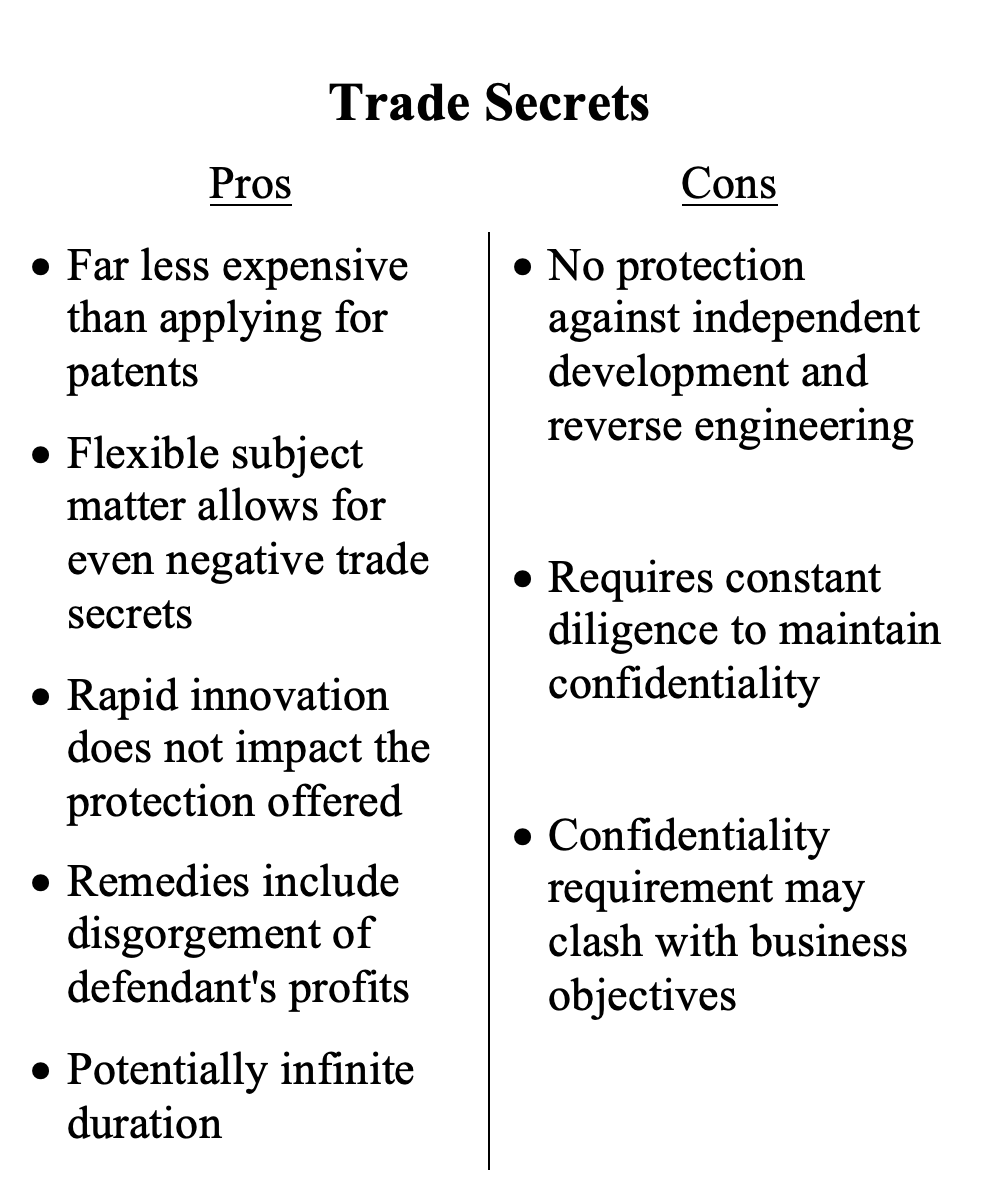“Trade secrecy features a far more pliable subject-matter definition, especially compared to the strict set of statutory categories found in patent law. The DTSA merely requires that the secret have “actual or potential” value derived from the secrecy.”
 A common refrain is that an invention is only as valuable as the patent that protects it. But what happens when you cannot secure the patent? This is a frequent hurdle for inventors seeking to patent products utilizing artificial intelligence (AI). While still in its infancy, at least compared to the lofty expectations of technology enthusiasts, AI has proven integral to driving innovation, but it has also proven equally vexing to fit into the intellectual property legal regime.
A common refrain is that an invention is only as valuable as the patent that protects it. But what happens when you cannot secure the patent? This is a frequent hurdle for inventors seeking to patent products utilizing artificial intelligence (AI). While still in its infancy, at least compared to the lofty expectations of technology enthusiasts, AI has proven integral to driving innovation, but it has also proven equally vexing to fit into the intellectual property legal regime.
Patentable subject matter is defined in 35 U.S.C. § 101 as “any new and useful process, machine, manufacture, or composition of matter, or any new and useful improvement thereof.” Notably missing from this definition is an exclusion describing ineligible subject-matter, but courts have long held that “[l]aws of nature, natural phenomena, and abstract ideas are not patentable.” Ass’n for Molecular Pathology v. Myriad Genetics, Inc., 569 U.S. 576, 589 (2013).
AI Meets Alice
 The difficulty encountered with AI technology is that patent claims directed to AI are often deemed abstract ideas. The United States Patent and Trademark Office (USPTO) has established a number of categories to distill the definition, but the overarching theme amongst these categories is that if a human mind can accomplish the task, then it is likely an abstract idea. Of course, AI is by its nature an attempt to replicate the human mind, albeit in perhaps an extravagantly advanced fashion. Thus, the difficulty of patenting this technology is quite apparent.
The difficulty encountered with AI technology is that patent claims directed to AI are often deemed abstract ideas. The United States Patent and Trademark Office (USPTO) has established a number of categories to distill the definition, but the overarching theme amongst these categories is that if a human mind can accomplish the task, then it is likely an abstract idea. Of course, AI is by its nature an attempt to replicate the human mind, albeit in perhaps an extravagantly advanced fashion. Thus, the difficulty of patenting this technology is quite apparent.
If labeled an attempt to replicate the human mind, it falls into the category of abstract idea and to avoid that category a patent claim must utilize an “inventive concept” in its application, which could transform the claim into a patent-eligible application. Mayo Collaborative Servs. v. Prometheus Labs., Inc., 566 U.S. 66, 72–73 (2012). In the 2014 case Alice Corp. v. Cls Bank Int’l, the Supreme Court held that merely implementing the abstract idea with a computer does not suffice to become an inventive concept. 573 U.S. 208, 214 (2014). Six years after the Alice decision, the collective prediction that Alice would only serve to deepen the abstract idea pit has been borne out in practice with decisions on patentability becoming murkier by the year.
Although the specific code underlying the technology may be patentable (or copyrightable), any patent protection on specific code would likely be too narrow to be useful. As a practical consideration, the world of AI – indeed technology as a whole – is exceedingly fast-paced. In the time it takes to secure a patent, that very patent might be obsolete. On the other hand, if a patent can be secured, patents offer a legal monopoly that can significantly safeguard AI technology.
The Upside of Secrets
To the extent patent protection cannot be obtained or would be too narrow to be useful, it is important to look at trade secret protection as an alternative. Trade secret law, which has been bolstered by the 2016 passage of the Defend Trade Secrets Act (DTSA), can be a significant way to protect AI technology (assuming it cannot be reverse engineered). The DTSA established much-needed federal trade secret law, containing a number of features aimed to reinvigorate what had become stale law underpinning trade secrets.
 Applied to AI, trade secret law ensures significant protection, particularly when a patent is difficult or impossible to obtain. Trade secrecy features a far more pliable subject-matter definition, especially compared to the strict set of statutory categories found in patent law. The DTSA merely requires that the secret have “actual or potential” value derived from the secrecy. 18 U.S.C. § 1839(3)(B). Thus, trade secrets can cover a wide range of potential subject matter, as long as the trade secret meets this low bar and cannot be reverse engineered, easily overcoming the abstract idea hurdle for patent law.
Applied to AI, trade secret law ensures significant protection, particularly when a patent is difficult or impossible to obtain. Trade secrecy features a far more pliable subject-matter definition, especially compared to the strict set of statutory categories found in patent law. The DTSA merely requires that the secret have “actual or potential” value derived from the secrecy. 18 U.S.C. § 1839(3)(B). Thus, trade secrets can cover a wide range of potential subject matter, as long as the trade secret meets this low bar and cannot be reverse engineered, easily overcoming the abstract idea hurdle for patent law.
This definition is so flexible that it has spawned the concept of negative trade secrets – past approaches that failed to work. This protects the process of trial and error, which is critically important to the development of AI technology. Negative trade secrets are often as valuable as the finished product itself.
Trade secret law meshes well with other features inherent in monetizing AI. AI technology is often utilized as the foundation for a core suite of services offered to clients, or at a stage in a process that ultimately produces a consumer-facing product. The secrecy element goes hand in hand with these uses. The secret formula of a company’s AI technology can be the competitive advantage it needs to establish dominance in its respective market.
Trade secrets require that the secret remain non-public. Such a requirement illustrates the potentially fleeting nature of trade secret protection. If the protected secret is reverse engineered or independently developed, then the protection vanishes. This stands in stark contrast to a patent where protection exists regardless of independent development or common knowledge that comes into existence after the patent application is filed.
At the same time, cementing this secrecy ensures a form of protection that complements the field of AI technology in a way that patents cannot. Fast-paced technological innovation often minimizes the lasting value of a patent, rendering some obsolete by the time they are obtained and, of course, a patent has a limited and expiring lifespan. This pioneering and limited time-environment has no bearing on the protection afforded by trade secrets.
A company need only set out to establish a confidential infrastructure that shields its new advances with trade secret protection. There is no filing or registration necessary. Once a company invests in the means necessary to ensure secrecy, those means do not fall apart simply because the technology changes; rather, the company now has the perpetual protection of trade secret law, regardless of what it seeks to protect. This protection never ends–at least not until the secret becomes generally known or is developed independently. Conversely, patents, by their very nature, defend against infringement of specific inventions. A new invention requires a new patent, and the costly patent application process starts from scratch.
Legal battles also remain with trade secrets – rather than engage in litigation to prove infringement, a company must instead demonstrate that the secret was misappropriated and that it took reasonable measures to maintain confidentiality. The DTSA and state law ensure that adequate remedies, including disgorgement of a defendant’s profits, exist for harmed plaintiffs.
In addition, the DTSA included a private right of action for misappropriation, which, if successful, can result in exemplary damages of up to two times the sum of the loss suffered and the unjust enrichment caused by the misappropriation. 18 U.S.C. §§ 1836(b)(3)(B)–(C). Injunctive relief is also available under the DTSA. § 1836(b)(3)(A). Somewhat controversially, the DTSA included a provision permitting ex parte civil seizure, § 1836(b)(2), which companies can employ in order to retrieve evidence and thwart further misappropriation. Although rarely granted, the ex parte seizure order nonetheless serves as an effective provisional remedy.
Take the Right Route
When it involves protecting sensitive and valuable AI technology, there are advantages and drawbacks of both patents and trade secret law. However, trade secret law undoubtedly offers protection where patents do not, and vice versa. Where Alice created a hurdle for patenting AI technology, trade secret protection can be available – not as a way to leap over the hurdle, but as a means by which companies can take a different route altogether.
Image Source: Deposit Photos
Author: sdecoret
Image ID: 207844888

![[IPWatchdog Logo]](https://ipwatchdog.com/wp-content/themes/IPWatchdog%20-%202023/assets/images/temp/logo-small@2x.png)


![[Advertisement]](https://ipwatchdog.com/wp-content/uploads/2024/04/Patent-Litigation-Masters-2024-sidebar-early-bird-ends-Apr-21-last-chance-700x500-1.jpg)

![[Advertisement]](https://ipwatchdog.com/wp-content/uploads/2021/12/WEBINAR-336-x-280-px.png)
![[Advertisement]](https://ipwatchdog.com/wp-content/uploads/2021/12/2021-Patent-Practice-on-Demand-recorded-Feb-2021-336-x-280.jpg)
![[Advertisement]](https://ipwatchdog.com/wp-content/uploads/2021/12/Ad-4-The-Invent-Patent-System™.png)







Join the Discussion
One comment so far.
Anon
February 25, 2021 09:27 amWhile recognizing the “legal reality” that the article points to, for those of us that recognize and understand the larger societal effects (beyond the immediate Quid Pro Quo that allows an innovator to turn their inchoate property right into a full set of alienable legal property rights) of a strong patent system, anything more than reluctant acceptance of the alternative trade secret route seems like blasphemy against the reason why our Founding Fathers designated the authority to create and control an innovation protection system to a certain branch of the government directly in the Constitution itself.